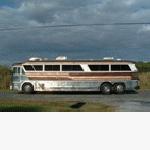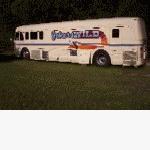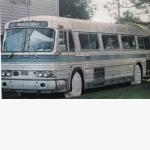| Author | Message | ||
| Tom (Oldmansax)
Registered Member Username: Oldmansax Post Number: 3 Registered: 9-2006 Posted From: 67.142.130.32  Rating: N/A |
The Wanderlodge PT40 I am working on came from the factory with the 12 volt coach & house electrical systems combined. There was only one set of batteries. The best I can figure from the original specification is the battery bank was 440 amp/hours. The original design included a battery disconnect that isolated some of the coach systems while camping. There was no way originally to completely disconnect all the batteries from the system. To further complicate matters, the PO tapped into the system for various after market accessories and some repairs without regard for where in the system the accessory might belong. Eventually I am going to separate the systems, but, for now, I need to get it on the road. I have already read a considerable amount about battery types & best practices. I know I should be using starter type batteries for the coach & deep cycle or AGM type for the house system. That is not possible as both systems are combined. It is not recommended to mix battery types in one bank & would be useless I think. The basic question is: What type of batteries should I use? A set of start type batteries? A set of deep cycle? A set of AGMs ? The original bank was 440 amp/hours so I can assume a start bank of that size would work; BUT, the Wanderlodge has so many phantom loads most owners only get a day or two out of the batteries before they are dead. I would like to do better if possible. If I use deep cycle or AGM batteries, do I need to make the bank larger to compensate for the starting load? Question #2: What is the amp draw of a 6V92T while starting in cold (+20F) weather? The PO installed a Link 200 to monitor the batteries. It uses a shunt on the ground side to monitor amp draw. The shunt is rated for 500 amps. I don't think that is big enough but I don't know. I know I can ground the batteries directly to the starter but that nullifies the amp draw function on the shunt. If the start current is more than 500 amps, can I switch the shunt to the load (positive) side? That way I can bypass the shunt with the starting load by running a cable from the batteries directly to the starter. I know I would probably have to reverse the wires so the Link 200 would read correctly. I already tried some ideas but none work to my liking. TOM | ||
| Tom Caffrey (Pvcces)
Registered Member Username: Pvcces Post Number: 1345 Registered: 5-2001 Posted From: 65.74.72.213 Rating: N/A |
Tom, we have always run starting current through our shunt and have never had any trouble doing it. I would avoid long cranking in cold weather if your engine is cold, however. If your 6V92T is less than 18:1 compression ratio, you should warm your engine with a block heater before cranking it. That will do the least harm in cold weather. Ether or hot air into the air intake will work very well, but ether can do a lot of damage and hot air may be difficult to come by and can lead to damage, as well. One to two hours on the 1500 watt block heater is very easy, with a little planning. For what it's worth. Tom Caffrey | ||
| Tom (Oldmansax)
Registered Member Username: Oldmansax Post Number: 4 Registered: 9-2006 Posted From: 72.171.0.145  Rating: N/A |
Tom C. Is your shunt 500 amp max? I have one on my MCI but it s rated for 1000 amp. I would be running the block heater except it is one of a million things that don't work.  TOM | ||
| Luvrbus (Luvrbus)
Registered Member Username: Luvrbus Post Number: 995 Registered: 8-2006 Posted From: 74.32.86.38 Rating: N/A |
Tom, the 42MT starter is what should be on the 6V92 they draw 1650 amps @ 12V 800@ 24V that is a 10.40 hp starter www.newindo.com that site has the hp and amp draw for all Delco starters. FWIW my DD bible for 92 series call for 900 amps @24V good luck | ||
| Tom Caffrey (Pvcces)
Registered Member Username: Pvcces Post Number: 1346 Registered: 5-2001 Posted From: 65.74.72.213 Rating: N/A |
Hi, Tom. Yes, our shunt is rated 500 amps, maximum. I'm not sure why they are rated so conservatively, but it's been no problem with any cranking we have done. I have no idea how long the shunt will handle such an overload. I note the currents that Cliff is pointing to, and they are higher than the ones that I have seen. When the engine was not very cold, I noticed a cranking current of 400 amps on our Link 2000, but it reports on samples, not average current. You might use an infrared thermometer to see how hot the shunt gets right after cranking. Good luck. Tom Caffrey | ||
| Tom (Oldmansax)
Registered Member Username: Oldmansax Post Number: 6 Registered: 9-2006 Posted From: 67.142.130.49  Rating: N/A |
Thanks Tom & Cliff. My 6V92 doesn't turn over as fast as some of the other Detroits I've had but I haven't tried it not going through the shunt. I know there is a problem because if I try to start the bus when anything is running like heat or lights, everything dies while the starter is engaged. As for the other question, has anyone changed the shunt to the load side? then I could bypass the starter circuit. TOM | ||
| niles steckbauer (Niles500)
Registered Member Username: Niles500 Post Number: 979 Registered: 11-2004 Posted From: 173.78.39.41 Rating: N/A |
Tom - I'd say you have a ground problem - FWIW "because if I try to start the bus when anything is running like heat or lights, everything dies while the starter is engaged" | ||
| Tom (Oldmansax)
Registered Member Username: Oldmansax Post Number: 7 Registered: 9-2006 Posted From: 67.142.130.21  Rating: N/A |
Niles, I think so too, that's why I am asking about the shunt. have already been over all the grounds, taken them apart & cleaned them. Reassembled with dielectric grease. The shunt is the only thing in the mix I haven't tested yet. I was kinda hoping to get a definitive answer on moving the shunt to the load side before I fooled with it at all. TOM | ||
| Luvrbus (Luvrbus)
Registered Member Username: Luvrbus Post Number: 996 Registered: 8-2006 Posted From: 74.32.86.38 Rating: N/A |
Tom, over the years if the starter has been changed it could have been replaced with one with a lower gear on the starter drive. I ran into with a friends 8v71 it spun slow and was hard to start because they used a 15 tooth gear on the bendix drive good luck | ||
| Tom (Oldmansax)
Registered Member Username: Oldmansax Post Number: 8 Registered: 9-2006 Posted From: 67.142.130.28  Rating: N/A |
Cliff, now that's new information. I have worked on a bunch of DDs over the years & never run into that situation. TOM | ||
| marvin pack (Gomer)
Registered Member Username: Gomer Post Number: 1166 Registered: 3-2007 Posted From: 71.55.1.12  Rating: N/A |
Tom, just thinking bac about some things and remmembered that I had a coach that the wiring from the batteries to the rear had the insulation get hot over the years and the wiring was burnt. When replacing it,all the insulation broke off and the cable was all bad. I put the batteries in the back bay ran new cable anyway to the front,repaired the block on the firewall, put new cable from the block to the starter and after that it would spin real fast like it was just shut off. Before it would take a few turns to fire but after the work it would only spin maybe a turn and fire. Just a thought, Check and see how hard the insulation is and if necessary cut it back and look at the wire condition. gomer | ||
| FAST FRED (Fast_fred)
Registered Member Username: Fast_fred Post Number: 1410 Registered: 10-2006 Posted From: 69.19.14.19  Rating: N/A |
The reason folks select start batts is they have the largest CCA (Cold crank amps) in a small space. What makes them work as starts is what kills them as House batts, loads of very thin plates (so huge surface area) that can provide the start current with out too much voltage drop, for a very short while. A large bank of house batts may well have even more surface area than a pair of starts and is how your coach was expected to be operated. Should a problem happen there was usually an isolated starting batt for the noisemaker , with either a big alt or a big charger , so in an hour or two, you are set to start. Some didn't even bother with the noisemaker batt , planning that a large house bank would have enough to crank a small (then mostly Gasoline gen set). This , starting from JUST a big house set does work, it would be a better choice with a block heater below freezing. FF | ||
| Tom Caffrey (Pvcces)
Registered Member Username: Pvcces Post Number: 1347 Registered: 5-2001 Posted From: 70.101.195.46 Rating: N/A |
Tom, the shunt at 500 amps just drops 1/20 of one volt. It's not likely to make a perceptible difference in cranking speed. Even at the rates that Cliff gave, you are still not looking at losing more than 1/4 of one volt. I think that your cranking problem is not caused by your shunt unless it is visibly damaged. For what it's worth. Tom Caffrey PD4106-2576 Suncatcher Ketchikan, Alaska | ||
| Tom (Oldmansax)
Registered Member Username: Oldmansax Post Number: 9 Registered: 9-2006 Posted From: 67.142.130.38  Rating: N/A |
The shunt appears good, but I am used to seeing batteries grounded close the their location and not 15' away to a shunt. I'll track this problem down once it warms up. Thanks! TOM | ||
| FAST FRED (Fast_fred)
Registered Member Username: Fast_fred Post Number: 1416 Registered: 10-2006 Posted From: 66.82.9.59  Rating: N/A |
Had a friend on a sailboat that decided he didnt give a damn about the amps used , except when it was time to go home. So to increase the response of the ammeter he filed down the shunt , till it read amps 10X higher. A filed down shunt is called a fuse! AS he soon learned. FF | ||
| FAST FRED (Fast_fred)
Registered Member Username: Fast_fred Post Number: 1417 Registered: 10-2006 Posted From: 66.82.9.59  Rating: N/A |
Had a friend on a sailboat that decided he didnt give a damn about the amps used , except when it was time to go home. So to increase the response of the ammeter he filed down the shunt , till it read amps 10X higher. A filed down shunt is called a fuse! AS he soon learned. FF |